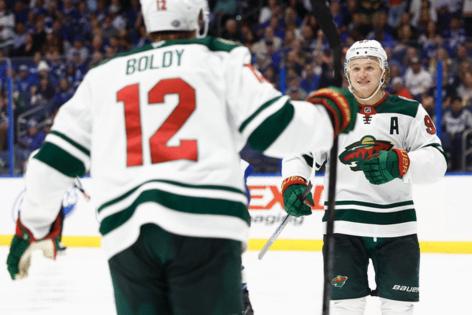Wild's start is one for the record books. Equally impressive: How they're winning.
Published in Hockey
PHILADELPHIA — The Wild were not curious one bit to see how they’d fare when they trailed for the first time this season.
“I don’t think we’re really looking to test the boundaries as far as that,” defenseman Zach Bogosian said.
But by blowing their lead on Thursday night against Tampa Bay and recovering for a 4-2 rally, the Wild validated the 19 periods they went without falling behind as more than a trend: They’re playing a style that’s clicking for them whether they’re up or down.
“That’s the way good teams win and build a culture that way and make sure things are going in the right direction,” Bogosian said.
At 5-0-2, the Wild are off to one of the best starts in the NHL.
Only they and Winnipeg have yet to lose in regulation, with the Jets a perfect 7-0 to lead the league, but the Wild are right behind them. They’ve won four in a row, and their seven-game point streak to open the season is one shy of matching the franchise record set in 2007-08 (7-0-1). The Wild can set a franchise record for the longest point streak on the road to start a season on Saturday afternoon at Philadelphia; they’re 4-0-1 as the away team.
“I just like the mindset that we’re playing with,” coach John Hynes said, “and we gotta keep going in the right direction.”
Last season, the Wild didn’t pick up their fifth victory until their 12th game on Nov. 7, but the results aren’t the only difference from a year ago.
How the Wild are winning is a stark contrast, too: They’ve scored first in all seven games, outscoring the opposition 8-1 in the first period. After their run of being ahead or tied in regulation ended at 391 minutes, 31 seconds — the second-longest season-opening streak in NHL history — the Wild trailed the Lightning for a brief 6:51. But Joel Eriksson Ek scored the equalizer late in the second period, and Matt Boldy regained the Wild’s lead on the power play early in the third.
The comeback, like their runaway victories, felt methodical, and that’s a nod to their structure, which has appeared much more second nature this season compared to last.
“We’re maybe more on the same page everywhere, every zone,” goaltender Marc-Andre Fleury said. “Guys know where to go, where they’ll be. So, I feel like when we get the puck, we don’t have to think or look around too much.
“We have an idea where the guys are at, and that allows us to move quicker and get out of the zone quicker and attack a little quicker in the offensive zone, find guys. And because of that, there’s no panic. We just stuck with it, and we didn’t open up and try to score [against Tampa Bay]. Worked out.”
That the Wild look more settled in their system makes sense.
After all, they just completed their first training camp with Hynes at the helm after learning his approach on the fly last season.
Back then, Hynes stressed quick exits to set up the team to play more offense than defense. But the Wild’s execution wasn’t consistent, and they missed the playoffs while finishing sixth in the Central Division.
Now, they’re much cleaner in their own zone: They’re tied with Winnipeg for the fewest goals against (13), and out of all the scoring chances they’ve given up, only approximately a third have been high-danger chances, according to Natural Stat Trick; the three high-danger goals the Wild have allowed are the fewest in the NHL.
In net, Filip Gustavsson has the second-best save percentage (.952) and goals-against average (1.40).
And when it comes to offense, the Wild are converting on almost 13% of their shots, which is above the league average.
The power play is top-five, going 7 for 22, and winger Kirill Kaprizov is tied for third in scoring with 13 points; his nine assists are also tied for third.
But the Wild’s success isn’t simply a reflection of their X’s and O’s.
What Hynes has also pinpointed as key are attention to detail, accountability and players’ willingness to understand how the team is supposed to operate.
“You can have structure and all those things,” he said. “But the game night in and night out really comes down to your competitiveness, your focus and your mindset. And when those three things are really in line, then everything else you’re trying to do usually gives you a good chance to win.”
©2024 The Minnesota Star Tribune. Visit at startribune.com. Distributed by Tribune Content Agency, LLC.







Comments